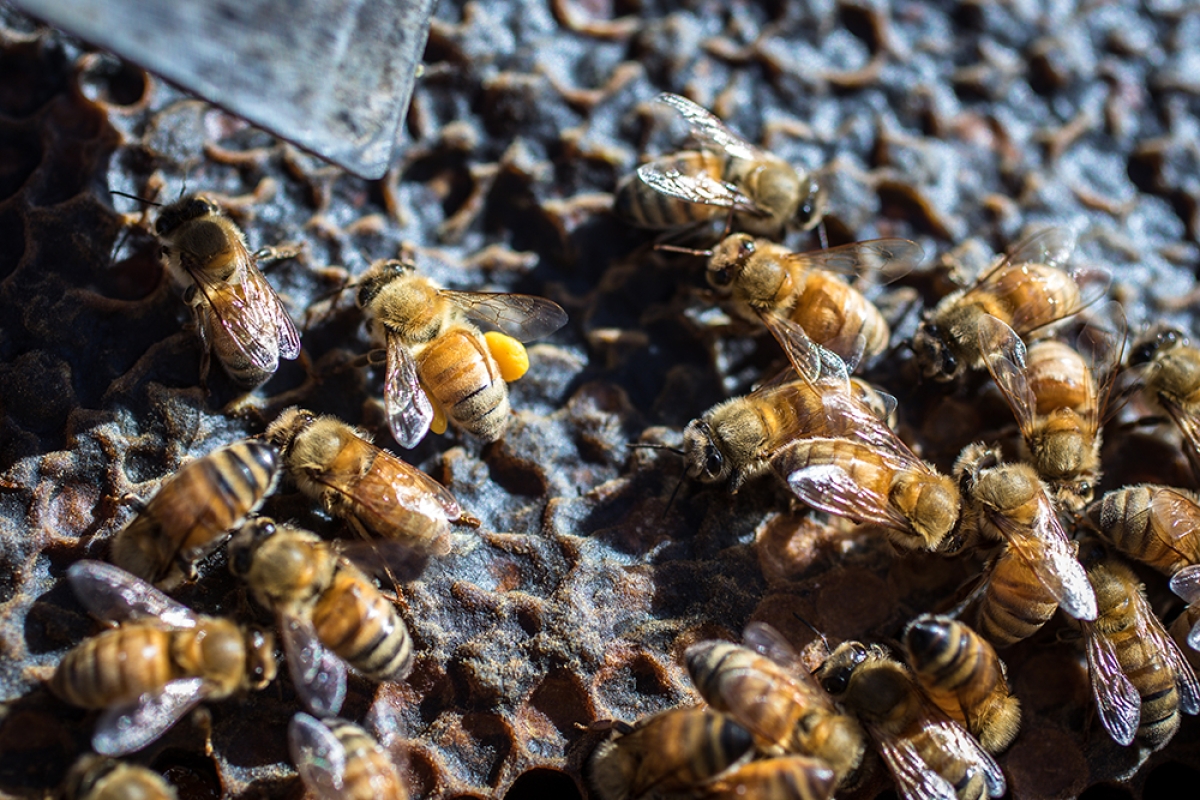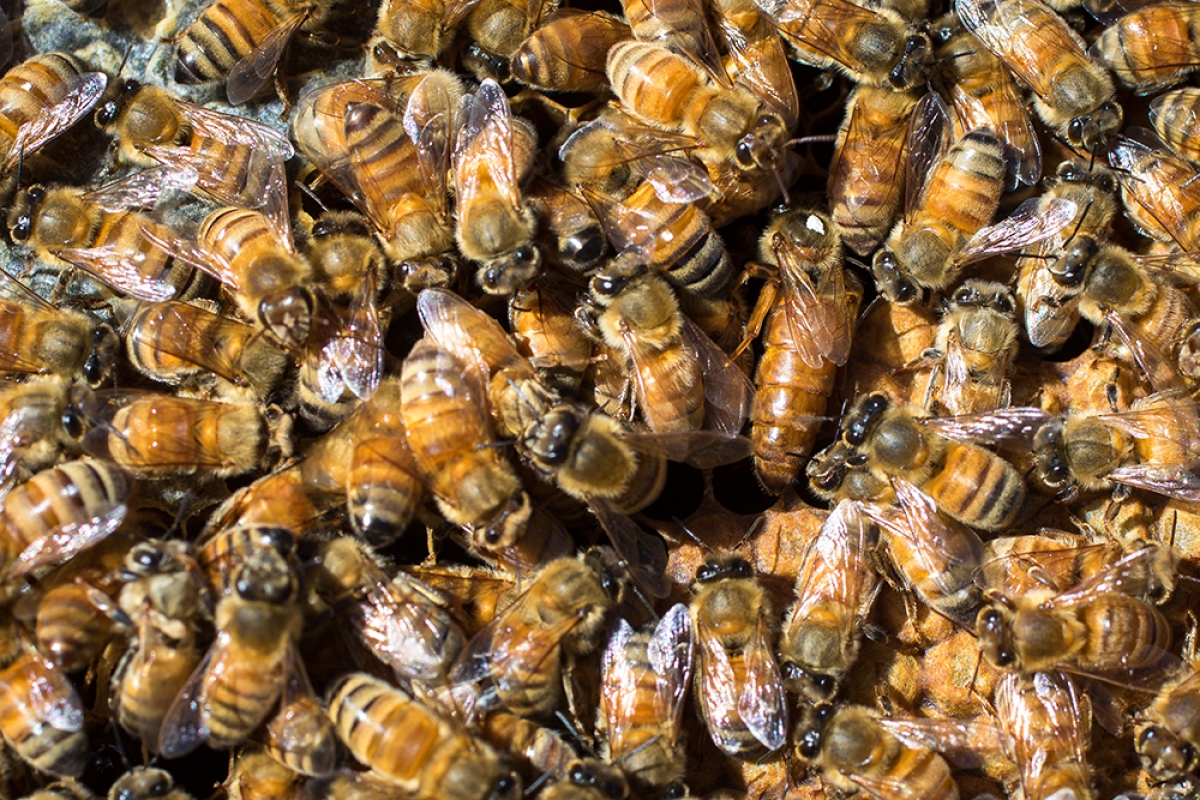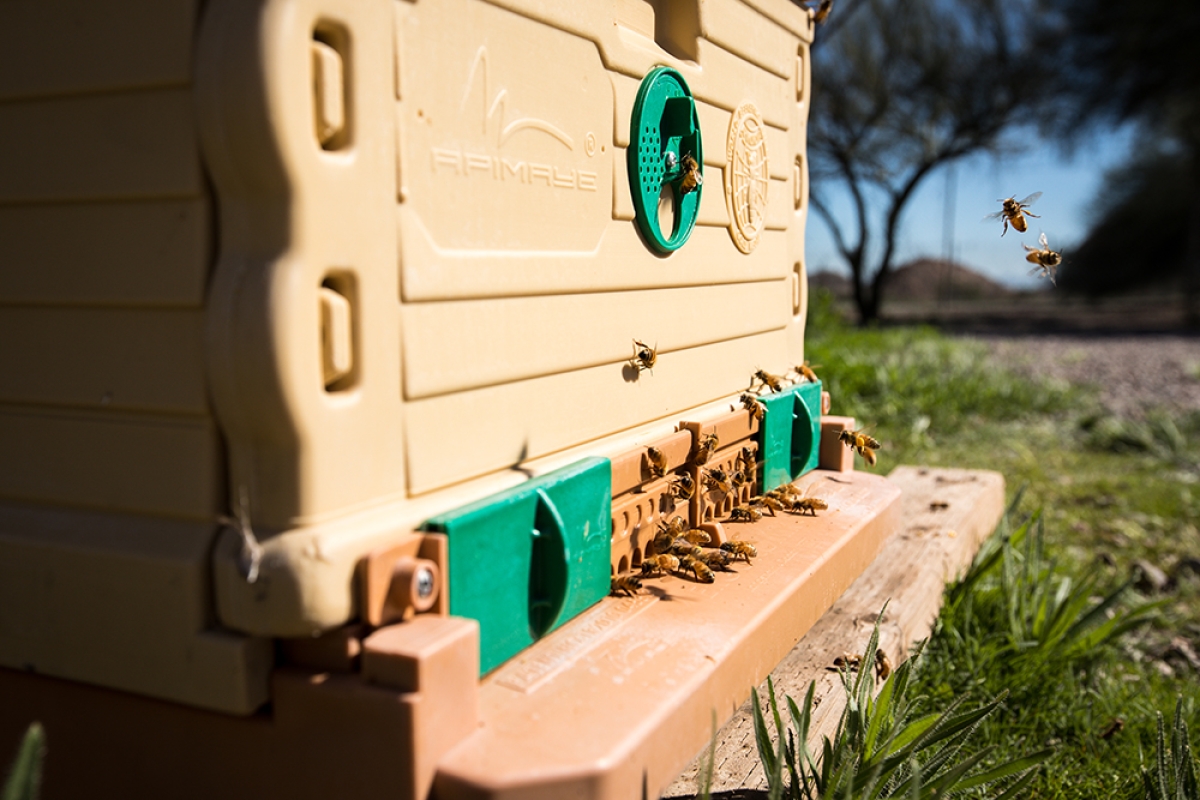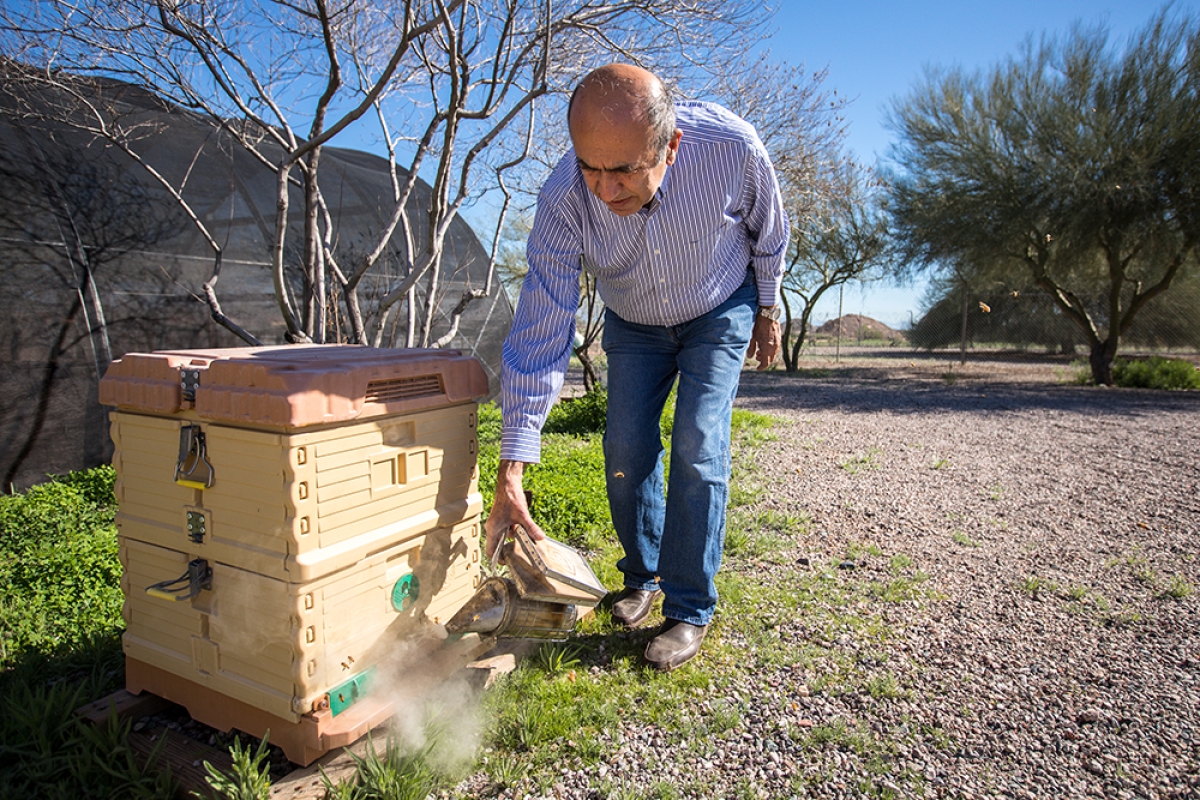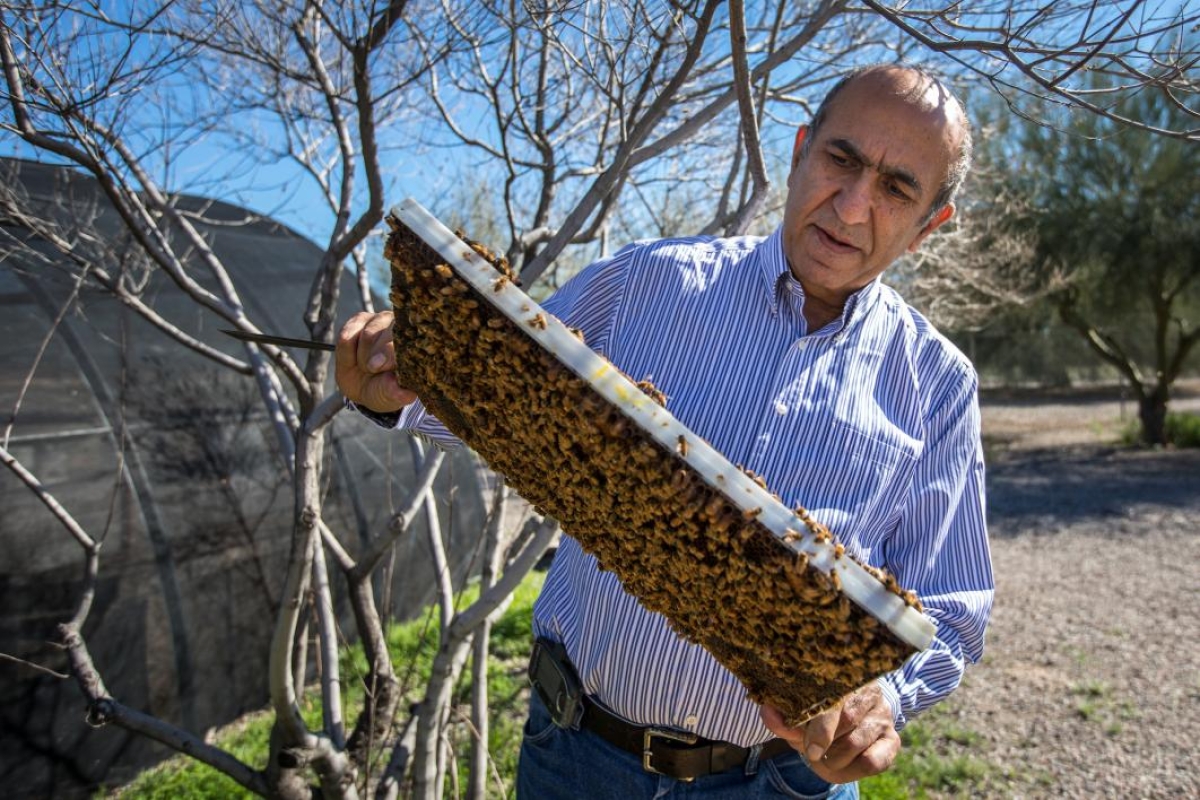It’s a silent, sunny day on the farthest corner of Arizona State University’s Polytechnic campus. There are only two people at the Honey Bee Research Lab, and not a peep can be heard in its two metal buildings.
But inside the observation hive in a classroom, it’s anything but quiet. Bees fly in from an outside door, stride across a plexiglass-covered walkway into the hive, and then climb up the comb to deposit yellowish globs of pollen (two each on their backs) into the honeycomb cells.
The bees are, well, busy. They bustle up the crowded comb — darting around oncoming bees, and knots of bees, and dancing bees — drop their pollen packs and hurry back down. It resembles nothing so much as rush hour in Grand Central Station, without the Oyster Bar.
In all, there are about 50,000 bees in this observation hive, said School of Life Sciences Bee Lab project manager Osman Kaftanoglu. Studies underway at the many research hives at the Bee Lab include work on colony collapse disorder, artificial insemination of queen bees, long-term storage of bee semen and territorial pattern observation. The facility holds two-day workshops for beekeepers and hosts international scientists in the spring.
Kaftanoglu has been getting ready to show the lab off to the public Friday (details below), allowing everyday people to see bees perform interpretive dance and learn about raids from rival colonies and insect counterterrorism efforts. The life of bees is intense. Peace is not a given in the garden.
“This is one of the biggest (bee) laboratories, and the most efficient laboratory in the United States,” said Kaftanoglu, a research technologist. “We have a really good season here.”
Back in the observation hive, there’s a huge cluster of bees around the queen, who is in a hurry herself laying about 1,500 to 2,000 eggs per day. The eggs are tiny white grains; an estimate of 1/20th the size of a grain of rice would be overly generous.
Bees who have found pollen dance their findings to the rest of the hive. They wiggle like crazed puppies, turning right, then left. She (all workers are sterile females) is letting the others know she has found pollen.
She’s not vague about giving directions. If she dances up the hive, the pollen is in the direction of the sun. If she dances down the hive, the food is in the opposite direction from the sun. If she dances quickly, the food is closer. Slow dancing, the food is farther. They can travel 3 miles for pollen.
“They get so excited,” Kaftanoglu said. “The closer, the better.”
The lab was founded in 2006. There are labs, offices, meeting spaces and storage areas. Out back, the hives sit widely spaced apart. There’s a water trough full of rocks at one end of the yard, covered in thirsty bees. A mesmerizing buzz fills the air. It’s a warm, sunny day, so the bees are all out and about. If it was cold, they would cluster together in a clump inside the hive and eat honey, much like you would do the same with popcorn and Netflix on a damp, chilly day.
“These are very nice bees,” Kaftanoglu said. “Gentle bees. ... There’s nothing to worry about with bees, unless they are Africanized.”
The lab doesn’t produce a lot of honey.
“Our aim is to do research here, not produce honey,” Kaftanoglu said.
ASU’s Bee Lab attracts researchers from around the world. A cohort from Germany is due next month.
“We have the expertise here, and we have the colonies here,” Kaftanoglu said.
Beekeepers nationwide also show up for two-day seminars to learn hands-on instruction and things like how to keep European bees from becoming Africanized.
“There’s a group of scientists here, and they’re all working on different aspects of bee physiology and bee behavior,” Kaftanoglu said.
He is working on the nutrition of bees and incubating bees, as well as a new USDA project studying the effect of pesticides on larvae and bee behavior. Another project is working on storage of honey bee semen in liquid nitrogen to preserve genetic stocks.
Jonathan Jackson is working on his biology doctorate. He is studying how honey bees guard against other rivals. They face a lot of threats — wasps, moths, humans, etc. — but there’s a lot of difference in what they pay attention to from their perspective.
“Honey bees will rob each other to death,” Jackson said. “They will beat up a weaker colony and steal all of its honey. It’s kind of important that the bees fine-tune their guarding, so to speak.”
They have to protect their nest from other honey bees, Jackson said.
“That presents some interesting challenges, given that a honey bee is a honey bee,” he said. “How do you distinguish between friend or foe when they look very much like you? When they even smell very much like you? I look at a recognition problem.”
They might compare the stranger to an internal template they have. The bee thinks, “Do you match what I think of as a nestmate?”
At certain times of the year and under certain conditions, bees are more or less accepting. They might accept strangers or reject nestmates.
“It’s a balancing act of how accepting they should be, trying to balance the costs and benefits,” Jackson said. “That’s what I’m looking at; what causes a shift in the general acceptance?”
If there’s a lot of food in their environment, they don’t have to be such diligent guardians. It’s easier for bees to go get food, rather than raid a rival hive and risk being killed by a guard bee.
Jackson is studying factors that might cause a shift in acceptance like food availability levels and the familiarity of one colony to another.
If you put hives close to each other, foragers will occasionally drift into the wrong colony.
“It’s not a small problem, actually,” Jackson said. In the wild, they would be miles apart from each other. For apiary purposes, hives are often placed beside each other. “We’ve been keeping bees for thousands of years, and we like to put them in a place where we can work with them. ... That’s a perfect scenario for the bees from one colony to drift into another colony.
“One of my hypotheses is that the bees may learn to be more accepting of these drifting bees because they’re not robbers; they’re not a threat. They’re there by accident, and they could be bringing in food. If they do the waggle-dance thing to communicate where food is, they could even be telling you where food is.”
A neighboring drifter could just have wandered into the wrong hive. A faraway drifter could be there to rob you. It’s like throwing a rowdy party where your neighbors wander in, which is fine — you recognize them — but you don’t recognize the three guys stealing CDs and all the rum.
“As much as we do know," Jackson said, "there’s still a lot we don’t know.”
Sun Devil Rewards is a free app that connects users to everything ASU. Earn "Pitchforks" for reading ASU news stories, checking in at events, taking polls, playing trivia games and more — and earn prizes that money can't buy (only Pitchforks can!). Win ASU gear, VIP tickets to games, backstage passes to ASU Gammage performances and tours of unique ASU spaces such as the bee lab and the School of Earth and Space Exploration's "clean labs" — even win a free month of working space at ASU SkySong. Download it from the App Store or Google Play.
Top photo: School of Life Sciences Bee Lab project manager Osman Kaftanoglu isn't worried about stingers at the research facility at the Polytechnic campus in Mesa on Feb. 21. Some of the work being done at the Bee Lab includes work on colony collapse disorder, artificial insemination of queen bees, long-term storage of bee semen and territorial patterns of bees. Photo by Charlie Leight/ASU Now
More Science and technology

Hack like you 'meme' it
What do pepperoni pizza, cat memes and an online dojo have in common?It turns out, these are all essential elements of a great cybersecurity hacking competition.And experts at Arizona State…

ASU professor breeds new tomato variety, the 'Desert Dew'
In an era defined by climate volatility and resource scarcity, researchers are developing crops that can survive — and thrive — under pressure.One such innovation is the newly released tomato variety…

Science meets play: ASU researcher makes developmental science hands-on for families
On a Friday morning at the Edna Vihel Arts Center in Tempe, toddlers dip paint brushes into bright colors, decorating paper fish. Nearby, children chase bubbles and move to music, while…




